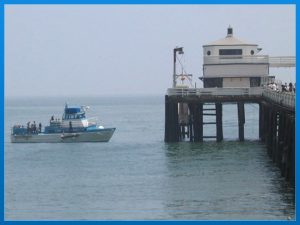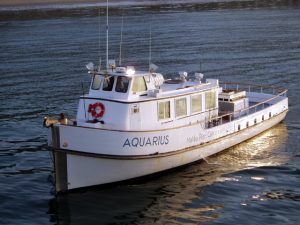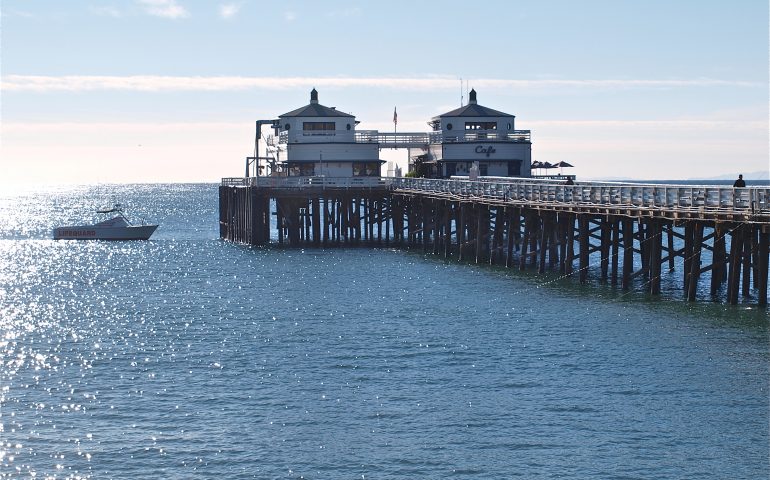Though the pier is now open to the public for fishing and recreation, the buildings on the pier remain empty. “When I started working as a lifeguard on the pier, it was really busy,” said Robinson. He has worked on the pier for 12 years. During that period, he has witnessed a lot of change. “There used to be restaurants, fishing boats to take people out on the water, and even a bait-and-tackle shop,” he said. “Nothing is left there now.”
Jefferson Wagner, master concessionaire of Malibu Pier, said that there are many unsolved issues, and the pier can’t open until these issues are resolved. Wagner is operations manager of Malibu Pier Partners (MMP), an investment company for the pier that Wagner started in 2001 with his partner, Alexander Leff, the CEO of operations.
There are three reasons that businesses have not been allowed to open yet on the pier, Wagner said. First, there is a trademark validation dispute for the pier image and name that has yet to be resolved. Also, Malibu Pier Partners said there may be some environmental issues with the pier that still need to be fixed before businesses can open safely. Lastly, businesses haven’t opened yet because Malibu Pier Partners has encountered some internal conflict about the future developmental plans for the pier. “The pier has not been able to open for business nor will it in the foreseeable future,” Wagner said.
The pier has withstood a stormy history. Built around the turn of the 20th century, the pier was commissioned by local businessman Frederick Rindge. It was built as a shipping wharf for hides and grains produced in the area and for receiving railroad ties and rails for the local railroad, Rindge Railroad.
It was first opened to the public in 1934. During World War II, the pier was used by the Coast Guard as a lookout post, and it is still used today by lifeguards as a watchtower and base of operations for most of Malibu’s coast. The building in which the famous Alice’s Restaurant has been housed was built in 1945. The Restaurant itself opened in 1971, quickly becoming one of the most popular dining establishments for locals and visitors alike.
However, the pier sustained heavy damage from the El Niño storms of 1982 and 1983, all of which weakened most of the pier and closed down Alice’s Restaurant. The state rebuilt the pier, but poorly, according to Wagner. Therefore, when strong storms devastated the coast again in 1993, the pier was so damaged that it was completely closed to the public until recent reconstruction beginning in 1999.
Reconstruction of the pier has cost the State of California, Los Angeles County, and City of Malibu a total of $10 million so far. According to Wagner, the three-phrase reconstruction process included demolition, piling and deck replacement, and building restoration since it is a historical site.
Despite the disappointment, many fishermen and local residents face every day at the pier, they still enjoy the historical landmark for its beauty and its community. “It’s the friendliest of all the local piers,” said Chance Smith, a local fisherman who lives in North Hollywood but comes to the pier every Sunday with his wife. “If one person catches something, everyone gets excited.”
Smith and his wife, Lee, who was nicknamed “Shark Lady” on the pier for her willingness to kiss sharks when people catch them, have joined the Malibu chapter of the fishing club Get Bent Sportfishing. Together with the other members, the Smiths join in picnicking on the pier, night fishing in the area and creating their own community right on the pier.
“Its one big family on the Malibu Pier,” Chance said. “It’s the only place where you can leave your [fishing] gear, grab some lunch across the street, and come back with everything still set up just as you left it.” The couple also loves to teach others, especially children, about fishing and about the sea life that they catch.
Robinson has also experienced the camaraderie of the pier, though not as much since the pier’s closure. “I used to get off work, walk by the restaurants on the pier, and hear ‘Hello, Bill’ from at least a dozen locals,” Robinson said. Robinson said that there is still a community on the pier, but he’s not sure if it will ever regain its former strength. —Megan Westervelt, Pepperdine University Graphic, March 16, 2006
In October 2006 it was announced that a Sportfishing operation would soon begin to run a boat, the Scorpio, from the pier. It would be the first such operation from the pier in more than forty years. The boat, skippered by Tom Durr and Rick Hayes, planned to primarily run three-quarter-day trips to the nearby Big Kelp Reef.

Eventually the Aquarius joined the fleet.

Then, in the summer of 2008, several businesses finally opened on the pier. Inshore at the land end were the Malibu Pier Club and the Beachcomber Café; out at the end, in the two Cape Cod looking buildings, were Ruby’s Shake Shack and the Malibu Beach Supply Co.
Malibu Pier Club, Beachcomber Cafe turn back the clock — The new restaurants tap historical plans to fit in with the restored Malibu Pier.
If you were building brand new restaurants at the land end of Malibu Pier, chances are they wouldn’t look like the just-opened pair that currently boast that priceless view of the surf. That’s precisely the point, said James Newland, supervising historian with the California State Parks, who helped oversee the restoration of the Malibu Pier, which recently reopened to the public.
The casual dining Malibu Pier Club and the finer-dining Beachcomber Cafe — each had to be built within the footprints and remains of structures that dated back to the pier’s early days. Historic photographs that included aerial views as well as vintage home videos, helped builders fill in the gaps. “The goal was to keep it to the historic period of the pier, the feel of 1945 to 1960,” Newland said. “It’s always a challenge for a commercial operator to come into a state park property, where our mission is about education and being open to the public.”
The pier. built in 1905, was a hot spot for film and TV shoots in addition to celebrity sports fishing. It even served as a lookout post during World War II. But it fell on hard times, in part due to storm damage, and was closed to the public in 1995. Since then, the state embarked on a multiyear effort to restore the pier. (For more details, read Times staff writer Martha Groves’ story about the history and the re-opening.
“The project had a number of constraints and challenges,” said Alexander Leff, principal with Malibu Pier Partners, the pier’s concessionaire, which came on board in 2005. “The pier is built out over the water. It’s made out of wood, much like an old wooden boat. The buildings are historic. The buildings were not handicapped accessible. But we understood the constraints. Preserving that historic character and authenticity of the pier is what differentiates the pier from a shopping mall in the Valley.”
Restaurateur Doug Cavanaugh, who leases the Beachcomber and the Malibu Cafe from the concessionaire, came to the project with a track record. He earlier opened a restaurant — also named the Beachcomber — at historic Crystal Cove State Park in Orange County, so he was aware of the challenges to be faced.
Sometimes, though, an attempt at keeping it real was a bit too real. At one point, restaurant plans called for extensive tile work that would have quite accurately recalled vintage Malibu Potteries tile. “It was an elaborate and detailed design that very much looked like tile artwork at the Adamson House,” Newland said. But that would not have been accurate, “You want to come up with something that reflects the feel and the period, but does not mimic historic features — you don’t want to fool people, or create a false sense of history,” he said.
Highlights of the evocative details at the restaurants include porthole windows and other maritime touches, a tiki-themed bar inside the Malibu Pier Club that is made of authentic period decorative pieces, historic photographs that line the walls, and a flat screen showing vintage home movies of Malibu beach life in the ’30s, ’40s and ’50s.
During those decades there were three sport fishing boats based at the Malibu Pier. The concessionaire tracked down the only surviving boat of the three, purchased it — Leff won’t say for how much, just that it cost “a lot” — and has returned it to service. Currently, the boat, the Aquarius, is one of three vessels working the pier. “The Malibu Pier is so beloved and iconic that we knew we were stewards of a very precious asset,” Leff said. Added Newland: “I think people can walk through here and get the feeling ‘Hey, this is what it was like in the ’50s’ and yet still have all the modern conveniences that we need to enjoy.” — Rene Lynch, Los Angeles Times, August 11, 2008Malibu Pier Facts
The reconstruction was deemed a success! In April of 2009 the Los Angeles Conservancy announced that the Malibu Pier was the recipient of its 28thannual “Preservation Award” as recognition for its outstanding achievement in the field of historic preservation. The Conservancy said that the “State of California showed solid stewardship of this beloved public resource by reversing decades of decay while staying true to its historic character.” Unfortunately the efforts expended to maintain authenticity did not compensate for a lack of business acumen. Although the Malibu Beach Supply Company remained in business all three restaurants—Ruby’s Shack Shack,the Malibu Pier Club, and the Beachcomber Café,closed by the end of 2011.
Nor, as it turned out, had the reconstruction itself been a total success. By 2011, 19 pilings had been found to be damaged, or were missing, and an additional $400,000 was needed for repairs. Given the manner in which state projects work, repairs had still not been finished by the end of 2013.
By 2014 Ruby’s Snack Shack was replaced by the Maibu Farm Pier Café a café featuring organic and local produce, good breakfasts, and delicious, if somewhat pricey California-style sandwiches.
Malibu Pier Facts
Hours: The pier is open from 7 A.M. to 6 P.M.
Facilities: There are benches on the pier and rod holders have been installed every five feet or so along the railing. Parking here can be a problem. Free and metered parking is available on Highway 1 which fronts the pier, but it is almost always hard to find a spot after the early morning hours. There is a parking lot adjacent to the pier open from 8 A.M. to 5 P.M., cost $10 a day, but it is often full. Out at the end of the pier sit two buildings, the one on the north side is Malibu Farm, a somewhat bohemian-type café with mostly organic food that’s fairly expensive but good. The one on the south side is the Malibu Beach Supply Co. It contains the usual tourist supplies (shirts, hats, pictures, etc.) but also some limited bait and tackle. This is where you but tickets for the Malibu Sportfishing boats when they are running. There is also a parking lot at the west end of Malibu Lagoon State Beach ($2 for all day) but it too fills early. Although limited bait and tackle is available at the end of the pier, you’ll have a better variety of both if you stop at Wylies B&T on your way to the pier (18757 Pacific Coast Highway, a short distance past Topanga Canyon) Road).
Handicapped Facilities: None.
Location: 34.036106319378085 N. Latitude, 118.67592573165894 W. Longitude.
How To Get There: The pier fronts on the Pacific Coast Highway (Hwy 1).
Management: California Department of Parks.
